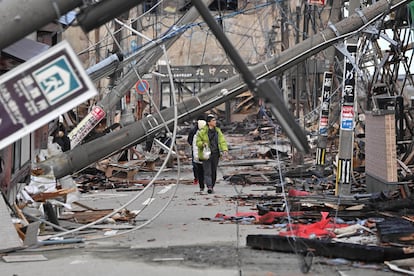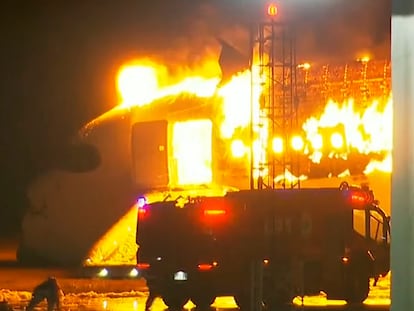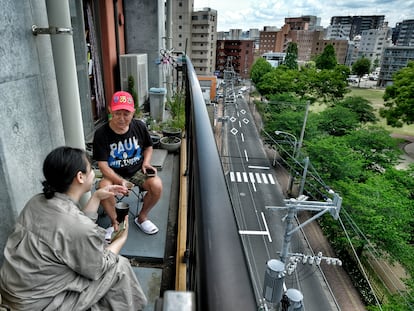A disciplined population and state-of-the-art technology help Japan cope with both earthquake and plane crash
Two traumatic events mark Japan’s start to the year, but the preparation to deal with such catastrophes has meant significant damage limitation

In the first 48 hours of 2024, Japan made headlines twice: on New Year’s Day, a 7.6 magnitude earthquake struck the center of the country, leaving at least 100 people dead. The following day, a Japan Airlines plane and a coast guard plane collided and caught fire at Tokyo’s Haneda airport. Although five of the six crew members aboard the coast guard aircraft died, all 379 people on board the Airbus A350 survived thanks to the flight crew’s quick response and the passengers’ attentiveness to instructions.
The coast guard plane was carrying supplies to help the area affected by the earthquake that had struck the Noto peninsula in the Ishikawa prefecture the previous day, forcing the authorities to activate a “major tsunami warning” along the country’s west coast. It was the most urgent warning since the triple disaster of 2011, in which a magnitude 9.1 earthquake, a giant tsunami and the Fukushima nuclear accident claimed a total of 20,000 lives.
Although the official figures of the New Year’s earthquake are not insignificant — 100 dead and 211 missing, according to a January 6 count — the consequences could have been far worse had it not been for Japan’s readiness for such disasters. September 1 marked the 100th anniversary of the Great Kanto Earthquake, a 7.9 magnitude earthquake that would change the course of the country’s history. More than 105,000 people lost their lives back then, 70,000 of them in Tokyo, while around 370,000 homes were destroyed. A century later, Japan’s seismology institutes are global leaders, with cutting edge seismometer networks and early warning systems.
According to Miguel Martínez Pañeda, senior structural engineer at Arup, the main difference in the ratio of deaths and damage between the Noto earthquake and other recent large-scale earthquakes, such as those in Morocco or Turkey, is that “Japan is very aware of the seismic risk” and that “most of its buildings are constructed in the knowledge that they will have to withstand an earthquake.” Martínez Pañeda told EL PAÍS that “in other places, there can be a generational time-lapse between one earthquake and the next, so the perception of risk can be lost.”
Japan is prone to earthquakes due to its location within what is known as the Pacific Ring of Fire, where 90% of the planet’s seismic activity is concentrated. The Asian nation records hundreds of tremors annually, albeit mostly of low intensity, and has consequently been reviewing and updating its construction laws and national seismic standard for decades, and incorporating lessons learned. “Unlike most European and American building codes, the Japanese focus not only on preventing collapse in the event of large earthquakes, but also on ensuring that buildings can continue to be used during small earthquakes,” says Martínez Pañeda.
Toshitaka Katada, a professor at the University of Tokyo who specializes in disaster management, told EL PAÍS that the government’s rapid response — a quick warning of an impending emergency was sent to cell phones and rescue teams were deployed — as well as public awareness of what to do in such situations, have also helped to save many lives. The Japanese learn from an early age how to act in the event of an earthquake and, every year, children and adults carry out evacuation drills. In the aftermath of the 1995 6.9 magnitude Kobe earthquake, which killed 6,000 people, community associations have proliferated to help prepare for potential disasters. In Katada’s opinion, “Japan is probably the best prepared country for such an event.”
Modern evacuation protocols
The diligence often associated with Japanese society was also instrumental in preventing the Haneda airport crash from turning into a tragedy. For many, it is a miracle that all 367 passengers, including eight children and 12 Japan Airlines crew members, escaped virtually unharmed. Only 17 people were injured, all of them now out of danger. While investigations continue to look into how the coast guard aircraft from which only the captain was saved ended up on the same runway as the Japanese company’s aircraft, experts say that the success of the evacuation is due to modern protocols and the professionalism with which they were applied.
According to Emirates flight attendant Bárbara Pérez Sánchez, “[Crewmembers] are highly trained to evacuate a plane in 90 seconds. We are very familiar with the procedures.” Pérez Sánchez also stresses the “exemplary performance” of her Japanese colleagues. According to the Japanese airline, 18 minutes elapsed from the time the plane stopped until the last person descended the emergency ramp. For Pérez Sánchez, the “amazing reaction of the passengers” also played a key role: “They did not panic, they remained seated, without getting up to pick up their bags, listening attentively to the crew’s instructions and following their orders,” she told EL PAÍS.
Many industry professionals have remarked online that the video Japan Airlines uses to explain to its travelers what to do in an emergency is a clear guide that prepares for a textbook evacuation. “It’s super accurate and super direct,” says Pérez Sánchez. “It highlights the seriousness of Japanese society and the value it places on safety.” There is an existing debate on whether these audiovisual products are effective. There has been criticism in recent years that they are more akin to a short film promoting tourism than a set of instructions.
Pérez Sánchez says that the plane crash “will be thoroughly analyzed” and will probably lead to “changes in general aviation regulations.” This happened in 1985, after a Japan Airlines flight from Tokyo to Osaka crashed into a mountain. It was the deadliest plane crash in aviation history: only four of the 524 people on board survived. That tragedy, which occurred after a faulty tail repair by Boeing technicians rather than the airline itself, is still very much kept in mind by the company which now implements one of the strictest protocols on the planet, as demonstrated by Tuesday’s evacuation. Consequently, it regularly appears as one of the 25 safest airlines in the world on Airlineratings.com’s annual list.
Sign up for our weekly newsletter to get more English-language news coverage from EL PAÍS USA Edition
Tu suscripción se está usando en otro dispositivo
¿Quieres añadir otro usuario a tu suscripción?
Si continúas leyendo en este dispositivo, no se podrá leer en el otro.
FlechaTu suscripción se está usando en otro dispositivo y solo puedes acceder a EL PAÍS desde un dispositivo a la vez.
Si quieres compartir tu cuenta, cambia tu suscripción a la modalidad Premium, así podrás añadir otro usuario. Cada uno accederá con su propia cuenta de email, lo que os permitirá personalizar vuestra experiencia en EL PAÍS.
¿Tienes una suscripción de empresa? Accede aquí para contratar más cuentas.
En el caso de no saber quién está usando tu cuenta, te recomendamos cambiar tu contraseña aquí.
Si decides continuar compartiendo tu cuenta, este mensaje se mostrará en tu dispositivo y en el de la otra persona que está usando tu cuenta de forma indefinida, afectando a tu experiencia de lectura. Puedes consultar aquí los términos y condiciones de la suscripción digital.
More information
Archived In
Últimas noticias
Most viewed
- Reinhard Genzel, Nobel laureate in physics: ‘One-minute videos will never give you the truth’
- Oona Chaplin: ‘I told James Cameron that I was living in a treehouse and starting a permaculture project with a friend’
- Pablo Escobar’s hippos: A serious environmental problem, 40 years on
- Chevy Chase, the beloved comedian who was a monster off camera: ‘Not everyone hated him, just the people who’ve worked with him’
- Why we lost the habit of sleeping in two segments and how that changed our sense of time











































